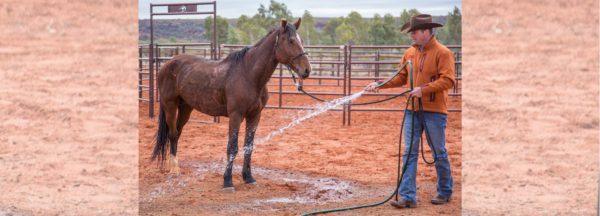Training Tip: Abused Horse Afraid of Being Bathed

Question: We rescued a 15-year-old horse that was severely beaten and went blind in one eye because of it. I have been working with him for months and he’s still untrusting of others and is very scared of water and whips. I’m just now able to touch his hindquarters without him jumping and breathing hard. I know how to not get him to be afraid of whips, but how can I get him to be not afraid of water? He starts breathing very heavily, and I let him see it and smell it. I start at his feet and work my way up, but he still jumps and moves away. His eyes get really big. Even on a very hot day in Texas, when I think he would love to be cooled down, he’s still very fearful especially on his hindquarters. How can I fix this?
Answer: I would forget about desensitizing him to water and focus on taking him through the Fundamentals Series. All the behaviors you’re describing—fearful of being touched, scared of whips, untrusting of others—will all go away when you earn his respect and establish a partnership with him on the ground. You do that by moving his feet forwards, backwards, left and right and rewarding the slightest try.
Once you have earned his respect and trust, you’ll find that introducing water to him won’t be a big issue. You’ll use the Approach and Retreat Method to build his confidence about being hosed off. Before even trying to touch his body with the water, you’ll desensitize the airspace around him. That gives him a chance to get confident about the water being sprayed around him. If he can’t tolerate it around him, he’s not going to stand quietly while you hose him off, no matter how hot and sweaty he is.
Start by spraying the ground 4 feet away from the horse’s legs. Keep the hose in the same position until the horse keeps his feet still and shows a sign of relaxing. A sign of relaxing can be him licking his lips, blinking his eyes, taking a deep breath, cocking a hind leg, lowering his head and neck or standing still for 15 seconds. As soon as he does both of those things, retreat by taking the hose away and rub him with your hand.
At first, it’s likely the horse will want to move around and try to get away from the water. That’s OK. If he moves, just follow him wherever he goes, keeping the hose in the exact same position in relation to his body.
The biggest mistake people make is taking away the water when the horse moves. That just teaches him that in order to make the water go away, all he has to do is run away from it. You want him to use the thinking side of his brain and stand still and relax.
Each time you approach the horse with the water, move it a little closer to his body until you’re able to spray the water right next to him.
Once he’s comfortable with you spraying the water next to his body, then you can begin running the water over his topline—his withers and back, hindquarters and neck. You’ll use the same Approach and Retreat Method to build his confidence.
When he’s comfortable with the water on his topline, move on to his legs. The very last area of his body you’ll introduce the water to is his face.
Trying to introduce water to him now when he’s fearful will just end up in a wreck, as you’re finding. When we get horses in for training, we don’t worry about hosing them off until they’re well through the Fundamentals and they’re using the thinking side of their brain and we can control their feet.
Watch me introduce water to a horse in the Outback Adventure Series in which I work with Bundy, a 10-year-old brumby stallion. We brought Bundy in from the Outback and I used the Method to introduce him to human touch and eventually start him under saddle. The series shows the process from haltering him to being able to ride him outside the arena. You can watch the series on the Downunder Horsemanship App or the No Worries Club website. The 13-part series can be found in the TV Show category.
Looking for more training tips? Check out the No Worries Club. Have a training question? Send it to us at [email protected].
